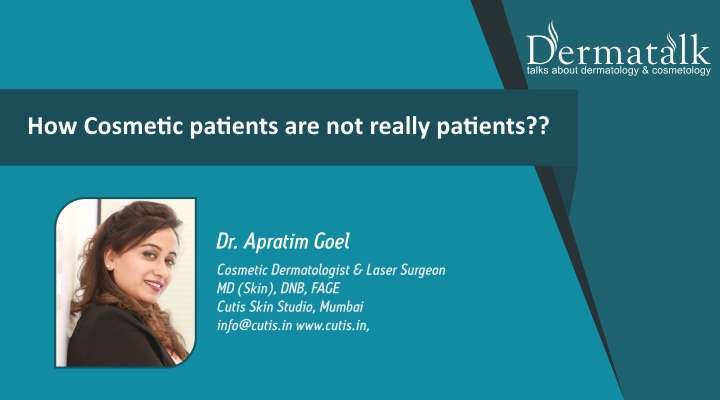It must be accepted that we cannot stay away from the advancing technology. Newer methods of communication and sophisticated modes of sending data and images are now available in everyone’s pockets. It is only natural that the general public would use this to deal with other people around them, which naturally include doctors as well.
Hello there!
Until two decades ago, the patient could speak to the doctor either when the latter is at home or at the clinic. At all other places the doc remained unreachable and therefore, undisturbed! Today with the cell phone boom, it is easy to reach the doctor anywhere including the wash room! So what do the patients want next?

Today patients are not satisfied with the land line telephone number. They want his mobile number and ‘WhatsApp” (for those who are not aware, it is a mobile application for instant text-audio-video communication) details so as to post skin images for instant treatment. “Doc, I have this patch of hair loss, pleaaase opine,” or “my lip is swollen like this, is it serious?” While some emergency situations are understandable, especially for old ‘follow up’ patients, such a method of seeking advice may not only be incorrect but sometimes downright dangerous.
There may be some situations for a dermatologist to ask for the image and then decide whether immediate attention is required or not. It could be a fast spreading or intensely disturbing disease like Erysipelas or Herpes zoster. Or it could be the post operative condition or an urgent blood report based on which to decide whether hospitalization is necessary or not.
“When ECG tracings can be forwarded online to a cardiologist and immediate opinion elicited what’s wrong in sending a picture of the skin lesion to a dermatologist?” is the current generation’s thought process.
Doctor, welcome aboard!
Doctors should get onto internet and mobile networks and use these technologies to their advantage. Just because you decide not to join the network it does not mean that the rest of the patients and one’s colleagues will stay away from it. Moreover, with the fast paced evolution of newer technology, not getting on board soon will make it harder to learn later on.
To begin with, let patients’ send email to you for better connectivity. There is a lurking fear in the minds of most dermatologists about how this move will turn out. The following questions commonly arise: Will the patient continuously bombard me with emails and expect instant replies? Will people stop coming to the clinic if they get replies on email? Will they pay for email advice?
Here are the answers:
Benefits to patient and doc
· Email access helps patients remain connected with dermatologist during office hours as well as when the doctor is on tour. Also when the patient is unable to come for follow up visits when he is away at work or secures university admission far away from home or when the patient is away on holiday.
· The basic and the greatest advantage in these situations is that they need not find a new doc in a strange country/city/village
For patients who are in town, it helps save their time in visiting and waiting just showing test
· reports and get confirmation on continuing same Rx. This is especially true for dermatologists who have a long line of waiting patients.
· Lesions which appear occasionally (e.g. Urticaria) and which do not appear when the patient consults in the clinic can be clicked and emailed to the doctor.
· Elderly patients and disabled who cannot be brought for consultation often can be helped if their family emails clinical progress to the dermatologist.
· In the case of conjugal dermatoses and the spouse does not wish to consult out of embarrassment, an image sent by mail to the doctor may help in the diagnosis.
· Sudden setbacks in lesion can be communicated instantly to doctor for reassurance or alternative advice.
· When an opinion of another doctor is sought (either from same specialty or a different branch) the findings can be communicated to keep dermatologist informed.
Doctor’s convenience
· With patients sending email of investigation reports there could be less crowding in clinic
· This becomes another parallel channel of consultation
· Small suggestions can be easily given to pt without wastage of time. e.g. Questions like: Doc, can I take the tablets with milk instead of water? … “Is it ok if I meet you two days later while continuing the medicines? …can be answered easily.
Pitfalls
Allowing patients to send emails will mean that the dermatologist has to check his email inbox at least once every day. It is yet another commitment of time which may not be easy for a less computer savvy clinician.
Email consultation can never replace regular consultation. It can only be used both by the dermatologist as well as his patient as an alternative mode of communication. It cannot be a method of consultation for a new patient who has not visited the doctor before.
Some of its significant drawbacks should always be borne in mind whenever the dermatologist offers to guide someone through online advice. A few of common limitations is as follows:
· As the patient walks in to a clinic and takes a seat, the doctor automatically observes his appearance, general health, gait, speech, social skills etc. This detail provides preliminary data which assists in the final diagnosis. In online consultation, this vital information is missing.
· There are medico legal issues if patient does not follow advice accurately and later complains against the doctor. Although the charges may not stick to the doctor, it can spoil his reputation.
· There is a risk of a disobedient patient repeatedly sending emails and not coming for follow up visits even when advised
· Non payment of consultation fees
· A doctor could have many patients with a similar name. He may misinterpret Ashok Savla as Ashok Surve if he has not met the patient for a long time. Very often plenty of time is wasted in searching email and identifying patient.
· If the patient is not computer savvy, and follow up emails are not sent in serial sequence the earlier prescription may not be accurately recalled by doctor while suggesting further treatment.
Create systems
While a dermatologist would be willing to help patients via email, there are some technical difficulties which may not be obvious to him till he actually starts the process. In order to make the procedure easy for the patient and convenient for the doctor he should make a perfect protocol that the patient should follow while sending email. Such a system allows the dermatologist to promptly respond to emails without any ambiguity. Here are some useful tips:
· A different email id should be maintained by the doctor for receiving his consultation mails so that it does not get cluttered with personal or ‘friendly’ emails.
· While sending mails patient should be instructed to mention their name right on top and the date of last consultation
· Preferably, the snapshot of the patients’ face and the lesion as well as the scan of the prescription should be attached for quick reference.
· Subsequent pictures should be sent along with the earlier ones and each should be appropriately dated.
· If there are two different skin disorders, both should be separately mentioned with serial numbers.
· Use the same email ‘thread’ for follow up emails so that the dermatologist can easily see what he has prescribed the previous month.
· A disclaimer should be clearly mentioned in each mail stating that any medication advised is only a guideline and that it should be consumed or applied ONLY after confirming with a local doctor, if the patient is in another town. The disclaimer should appear both above and below the medicines advised.
· Follow up visits should be clearly defined even when suggestions are given on emails so as to prevent misuse and misguidance. Email consultation should be discontinued if the patient fails to attend the clinic as advised or if appropriate reports are not sent.
· Payments can either be collected through family members visiting the clinic or through online payment systems by providing account details. In this case please provide a case number to the patient and instruct the patient to mention this number in an email specifically with the details of the paying bank, time and date of amount transfer.
In conclusion, it must be remembered that prescriptions and advice through emails should only be used as an adjunct to regular clinic consultation. Under Indian laws there is yet no clear description on how online consultations can be carried out. For websites that exclusively provide online consultation as a service it is necessary that all prescriptions should carry a secure digital signature for which a specific procedure is to be followed as provided under the Information Technology Act 2000.











